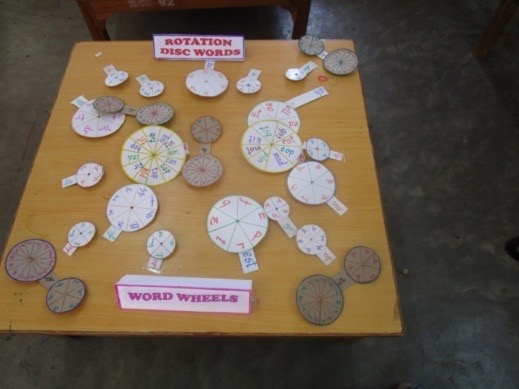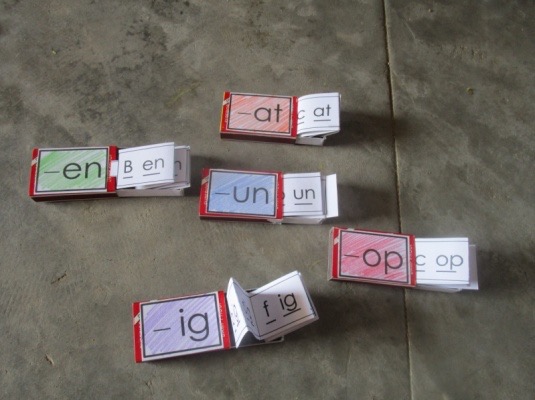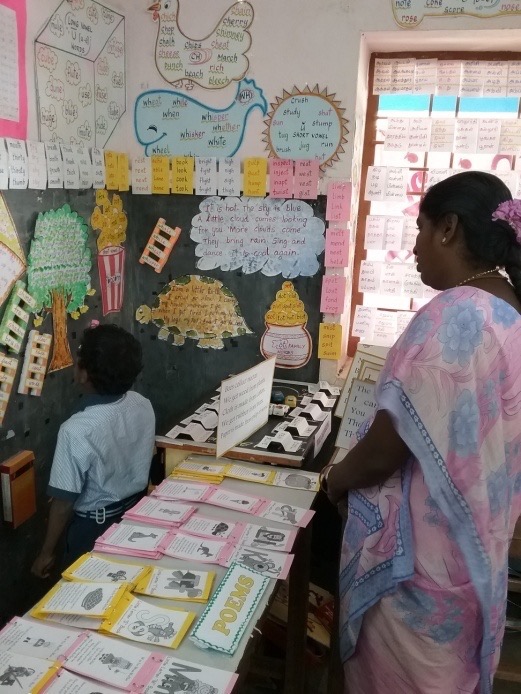Genesis: Once we learn to read, we will forever be free - Fredrick Douglass (American Orator, Writer and Social Reformer)
Students especially at their early stage find it difficult to decode words in English. They generally depend on their teachers. In my school, the parents have very little time to spend with their children but they expect them to be well versed in English.
As learning English is the need of the hour, reading in English becomes necessary. To make reading easier, more enjoyable, more interesting and effortless, I decided to follow the Phonic Way to teach students of Class 1, framing my own steps on the way. Later on, my school staff joined me and we started planning and preparing for the annual Reading Day Festival.
Preparatory work and Designing:



Only when a child gets interested in something, then can he begin learning about it. Hence for the first four months, we gave more and more activities through which children got ready for reading. Also more training and drill were given to them in their first language i.e. Tamil such that they could spell and read easily before starting with English.
We planned our teaching to address three types of learners (visual, auditory and kinesthetic). We prepared the following attractive and colourful resources to help learners read phonically.
Letter cards, Word cards, Flash cards, Sliding cards, Label cards, Fixing cards, Picture cards with and without words, Sentence cards, word family spinners, Word towers with stacking cups, Word family ball toss, Rotation discs, Clip and cards, Stick and clip cards, Dice board games, Snake and Ladder games, Word list boards, Words in hangers, Audio of words, Memory match cards, Instruction cards, Flip cards, Poem cards, Story cards, Clue cards, Phonetic books, Big books, Tongue twisters, Course books, Library workbooks, SSA books, Newspaper cuttings, Practice Worksheets, (Filling, Choosing, Matching, Coloring, Odd man out, Yes or No, Comprehension, picture recognition and rearranging the letters etc.), Cut and paste sheets, Word search sheets, Camera for recording the reading of the students and reinforcing them for their improvement.
We first made sure that all the students knew the names of the letters of the English alphabet and could recognize them in print. We coupled reading with writing so as to develop both at the same time.
Preliminary steps:
- Shouting meaningless words
- (கொய்யோ, மொய்யோ, ஆ..ஊ.. ஈஈஈ.. la, lu, blaw, blaw etc.)
- Moving lips in different position.
- Mouth gymnastics in front of mirror.
Blowing games:
- Blowing bubbles/ balloons.
- Blowing paper balls/pompoms with mouth/straw.
- Inflating and deflating the cheeks.
Lips movements:
- Giving kisses to one’s own palm.
- Holding a kiss for a minute.
- Pinching lips around edges.
- Making noise of car (BRRRR….) lips alone vibrate.
- Alternating between a kiss and a smile. (say I and U alternatively)
- Holding any eatable (வற்றல், உருளைக்கிழங்கு, கடலை, தண்ணீர்.) and spitting them away as far as possible.
- Pressing lips strongly and bursting it open.
Tongue movements:
- Licking lollipops.
- Touching upper teeth.
- Touching upper and lower lip.
- Touching corners of the mouth.
- Tongue dancing for any rhymes.
- Massaging the hard palate.
- Closing /opening of mouth holding tip of tongue onto the palate.
- Repeat LaLa, LeLe, LiLi, LoLo, LuLu (mouth not moving, tip of the tongue always touching the palate.)
- Repeat TaTa, TeTe, TiTi, ToTo, TuTu
- Changing voice LaLaTaTa, ….
- Movement alone is important and not the speed.
Some more exercises:
- Practice Jaw exercises.
- Chewing motions, pain actions, angry, and some other emotional movements in jaw or mouth (some clippings of Mr. Vadivel, comedian)
- Humming gently
- Jaw sideways movement, stretching / opening wide.
- Practice breathing in and out.
- Avoid speaking with clenched teeth (பற்களைக் கடித்துக்கொண்டு பேசுதல்)
- Staying hydrated – Getting your vocal cord oiled with lukewarm water with salt. Just rinsing your throat and spit.
Important Notes:
- தாய்மொழியை எழுத்துக் கூட்டிப் படிக்கத் தெரிந்த குழந்தைகளுக்கு phonics (ஒலிப்பு முறை) . எளிமையானதும் ஆகும்.
- LKG - உயிர்; எழுத்துகள், UKG- மெய் எழுத்துகள் (படங்களுடன்)
- அ அ அ – அம்மா ……அ அ அ – அணில்
- க் க் க் – பாக்கு …க் க் க் - நாக்கு
- English- LKG- Name and picture of the letters of the Alphabet , UKG- Sound and picture of the letters of the Alphabet . Aaa-apple, bbbb- ball..
- I std- உயிர் மெய் எழுத்துகள் - சேர்த்தும் பிரித்தும் படிக்கப் பயிற்சியளித்து உதவுதல் (படங்களுடன்)
- க் + அ = க..
- ங் + அ = ங…..
- I- std முதல் நான்கு மாதம் தமிழில் உள்ள எழுத்து ஒலிகளை மட்டும் படிக்க உதவுதல் (படங்களுடன்)
First four months English- Listening and speaking importance listening and speaking
- I-std- gradually adding the sounds in the words (three letters with pictures)
- Never start with the textbook. Start with the black board, flash card, floor writing, sand tray, floor writing, wet cloth writing.
- Start phonics only after children have sufficient grasp of auditory signs, can recognize printed letters and understand English to some extent.
- In phonics, Analysis to synthesis takes place.
- Phonics helps to avoid spelling mistakes.
- Phonics is rhythmic generalization hence are loved by the primary children.
- Never expect a child who can read English to say the meaning of what is being read by himself/herself.
- Only one at a time can be done even at the age of 10 . If a child reads, it’s brain concentrates only on the sound of the letters/words.
- If someone reads, children can listen and say the meaning. (Reading + saying meaning at a same time takes some time for a known passage)
Abnormalities may be due to..
Speech or language delay, Deafness, Habit of prolonged use of baby bottles, thumb sucking, Ear infection, Oral breathing- makes tongue lie low, Thickness of the tongue, Arched palate etc.
If a child has none of these, then we can surely help children read in English using the Phonic Method.
Sounds of letters – some tricks
C,K,Q = விக்கல் (அழுத்தி)
D = தலைமுட்டுவது (டிடிடிடி)
F = காற்று ஊதுவது (காயத்தில்)
G = விக்கல் (அழுத்தாமல்)
H = வாயால் மூச்சி விட்டு வாங்குவது (ஓடியபின்)
L= நக்குவது
M= ம் ம் கொட்டுவது
P= soda bottle திறப்பது
R= வண்டி engine சத்தம்
S= பாம்பு சீறும் சத்தம் (close the ears with the fingers- no buzzing sound)
T= கதவு தட்டுவது
V= bite it – கீழ் உதடு கடித்தல்
W=kiss it/ vomit it.
X = க் + ஸ்
Z = Close ears with the fingers- could hear buzzing sound
Results and Outcomes of teaching using the Phonic Method:
- After 6 months of work, we conducted our 3rd Reading Day Festival. It was inaugurated by our respected Deputy Inspector of Schools, Mr. M.G. Robert Kennady, who appreciated the children and the staff for their work.


- 92 visitors came to our school, out of which more than 50 were teachers of other schools while the remaining were the people from our village.
- The parents were very proud and happy that their children could read English fluently, that too phonetically.
- Our children were able to decode the words quickly without spelling them.
- III Std children could read and say the meaning simultaneously. Also they are well versed in referring the Dictionary.
- II Std kids could read and say the meaning of certain sentences.
- I Std kids could read and say the meaning of certain words.
- This year children also read the Tamil Language to the visitors.
- They were not frightened to read aloud. They participated in a reading competition and won at the Zonal level.
- They can now teach themselves and their juniors to read and are even able to correct our mistakes.
- The students can read question papers and answer by themselves.
- The school strength is increasing as our students’ reading skill is being talked about.
We are sure that if the phonic way of reading is followed and practiced in all the government schools, it will definitely be a great success.
Bibliography and References:
Though the main idea is ours, we also got the support of books and websites for generating the worksheets and activities.
- When children can’t read what teacher can do? – Kylene Beers.
- Phonetic Readers of various publications.
- English Readers and Course Books of NCERT (Our books) and Kerala and Karnataka states.
- SSA, Puducherry Four level mini books and ABL picture and Flash cards
- Our school library workbooks (Aggarwal and Macmillian)
- www.themeasuredmom.com
- www.soundcityreading.com
- www.abcfastphonic.com
- www.icanteachmychild.com/wordfamily-activities/
Teacher: R.Anitha, PST , GPS Agaram
Term: Term 3
- Log in or register to post comments